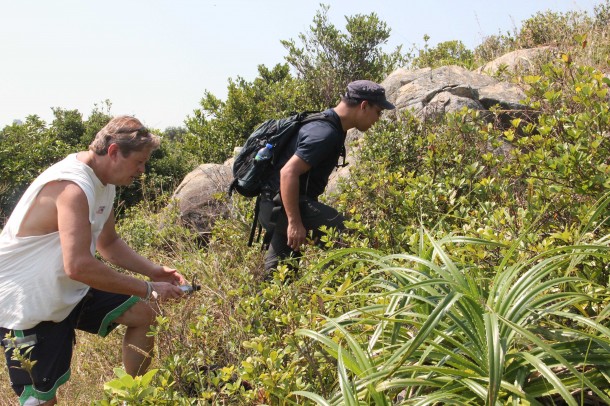Geocaching – all you need is courage, curiosity and a GPS device for you outdoor adventure.
Reporter: Carmen Shih
Feeling quite seasick after their journey to the remote island of Ng Fan Chau near Shek O, two young men eagerly jump off the boat as it approaches shore. They land on rocks and climb quickly into a tangle of bushes. The men look like characters in an action movie but, in fact, they are modern day treasure hunters taking part in geocaching (ge-o-cash-ing), a pastime that combines travel, hiking, navigating and exploring.
Geocaching is a worldwide treasure hunt using modern technology. With Global Positioning System (GPS) receivers or smartphones, participants look for hidden containers known as geocaches (or “caches”) whose coordinates are listed on geocaching websites. Every geocache contains a logsheet or logbook. Participants, who are known as geocachers, can write down how they got to the cache and share their feelings about it.
Geocaching uses technology to pull people away from their computers and into the great outdoors. “The most important part is the idea of finding an adventure at a location, the idea that you can go out and then you’ll find an adventure somewhere,” says Jen Sonstelie, the marketing manager for Groundspeak, the company that runs geocaching.com.
Currently, there are over 1.5 million active geocachers all over the world.
The game started on May 30, 2000. It quickly spread to different parts of the world — and even into space. The first traditional geocache in Hong Kong was hidden in January 2002 by Joan Garcia, a chemist from Spain. He hid the cache, named “Tram Peak”, inside the Lung Fu Shan Country Park, near the peak of High West.
“It is very important to choose a place you know others will enjoy, don’t just go with a box to a place you still do not know and try and find a place,” says Garcia, who chose the location because it has a view of both skyscrapers and dense vegetation.
Garcia was delighted that he hid the first cache in Hong Kong. “I try to imagine how other people will live the experience.” He even left a camera in the box for the geocachers to take a picture of themselves.
There are currently more than 400 active caches in Hong Kong and local geocachers have established a geocaching community with around 30 active members. Jimmy Tang Tai-kwan, one of the young men at Ng Fan Ch au, started geocaching in 2005. Tang, who is a software engineer, acquired a GPS chip through work. His research revealed that geocaching was one of its uses.
Although Tang grew up in Hong Kong, he says geocaching has allowed him to learn more about the place. His most memorable cache in Hong Kong so far is the “Pillbox” at Wong Nai Chung Gap. A pillbox is a type of military bunker and the pillboxes at Wong Nai Chung Gap date from World War Two.
“Climbing into the water tunnel was the only way that I could reach the cache. It was steep but not very dangerous. I estimate the risk before I take action,” says Tang.
The search itself was rewarding because it led him to the best preserved pillbox in Hong Kong. The cache is owned by a geocacher who loves WWII relics.








































